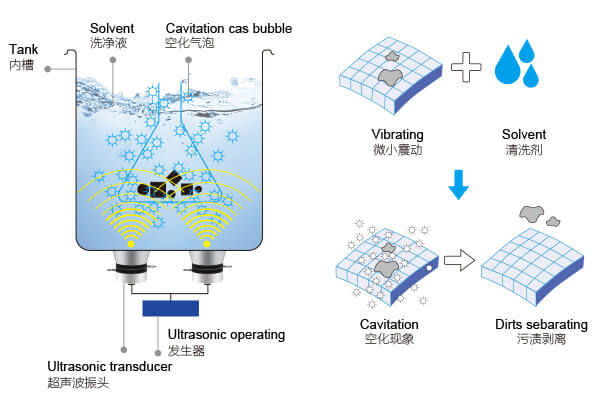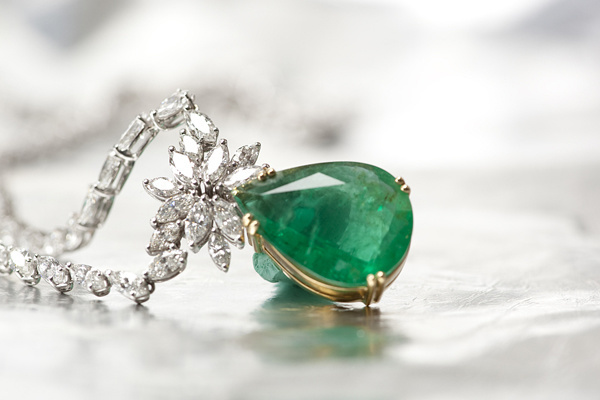Ultrasonic Cleaning for Jewelry: What You Need to Know
Browse Volume:3 Classify:Support
Jewelry, by its nature, accumulates the kind of grime that’s nearly impossible to clean thoroughly by hand. Dust, oils, sweat, soap residue, and other particles can lodge themselves deep into crevices, prong settings, or chain links. That’s where ultrasonic cleaning offers a distinct advantage—it cleans where brushes and cloths can’t reach.
Ultrasonic cleaners use high-frequency sound waves, typically between 20 and 200 kilohertz, to create microscopic bubbles in a liquid cleaning solution. This process, called cavitation, causes the bubbles to form and collapse rapidly, releasing focused bursts of energy that loosen and lift away contaminants from surfaces. The effect is both thorough and non-abrasive, which makes it ideal for cleaning intricate pieces like rings with stone settings, filigree earrings, or detailed pendants.

The Principle Behind Ultrasonic Cleaning
Unlike manual cleaning, ultrasonic cleaning doesn’t rely on scrubbing or harsh motion. Instead, it lets physics do the heavy lifting. When used correctly, it can restore a piece’s original brilliance without damaging the structure or material integrity of the jewelry.
Ultrasonic cleaning is widely used in both commercial and personal settings—from local jewelers to high-end watch manufacturers, to home users with portable tabletop units. But before tossing your heirloom ring into a vibrating bath, it’s essential to understand what’s safe to clean and what isn’t.
What Types of Jewelry Can Be Safely Cleaned
Not all jewelry is created equal. Some pieces are robust and made from materials that can easily withstand ultrasonic vibrations, while others are delicate, porous, or chemically treated in ways that make them unsuitable for this method.

Jewelry
Safe Metals
The good news is that most metals used in high-quality jewelry are perfectly safe to clean ultrasonically:
- Gold, especially solid 14K or 18K
- Platinum
- Sterling silver, though tarnish might require a specific silver-cleaning formula
- Titanium and stainless steel, common in modern and minimalist designs
These metals are durable and non-porous, meaning they won’t react adversely to cavitation.
Safe Gemstones
Some gemstones are resilient enough to handle ultrasonic cleaning without issue. These include:
- Diamonds, the hardest natural substance on earth
- Sapphires and rubies, which are varieties of the hard corundum mineral
- Cubic zirconia, a man-made but very sturdy material
- Amethyst, topaz, aquamarine, and garnet, though some caution is still advised
Even for these stones, it’s wise to double-check that they haven’t been treated or fracture-filled—modifications that can make even durable stones vulnerable to ultrasonic stress.
Construction Considerations
Equally important is how the jewelry is constructed. Loose prongs, poor soldering, or glued settings can all be problematic in an ultrasonic cleaner. Cavitation forces may loosen or dislodge small stones if the settings aren’t secure.
A general rule: if a piece is well-made and composed of hard, non-porous materials, it’s likely safe to clean ultrasonically. But for anything vintage, fragile, or glued, it’s best to consult a jeweler first.
Jewelry That Should Not Go in an Ultrasonic Cleaner
Despite the effectiveness of ultrasonic cleaning, some materials and designs are simply too fragile for this process. Cleaning these in an ultrasonic bath can result in irreparable damage.
Porous or Soft Gemstones
Some gems are too delicate or porous to survive ultrasonic vibrations:
- Opals, which are water-rich and can crack or craze
- Pearls, which have organic nacre easily eroded by cavitation
- Emeralds, often fracture-filled with oil to enhance clarity
- Turquoise, coral, lapis lazuli, and malachite, all of which are soft and sensitive to heat and chemicals
These stones can absorb liquid, lose polish, or even disintegrate under ultrasonic exposure.
Treated or Coated Stones
Many lower-grade gems undergo treatments to enhance their appearance—such as color dyeing, fissure filling, or coating with polymers. Unfortunately, these enhancements often aren’t disclosed at purchase. Cavitation can strip away these treatments, leaving behind a dull, damaged stone.
Ultrasonic cleaning is not recommended for:
- Heavily treated rubies or sapphires
- Irradiated blue topaz
- Lead-glass-filled gems
If you’re unsure whether a stone has been treated, err on the side of caution.
Glued Jewelry and Costume Pieces
Many costume jewelry items, and even some fine pieces, use glue to secure stones or attach parts. Ultrasonic cleaning can loosen or dissolve the adhesive, leading to parts falling out or getting lost in the tank.
Even well-made pieces can become risky if they’ve had recent repairs involving glue or resin. Always wait until adhesive has fully cured, or clean by hand if unsure.
Many experienced jewelers and gemologists recommend avoiding ultrasonic cleaning for porous or heavily treated gemstones. It’s generally considered safer to have such pieces inspected by a professional before exposing them to any aggressive cleaning method like ultrasonic vibration or heat.
Understanding How Frequency and Power Affect Jewelry Cleaning
Ultrasonic cleaners aren’t just plug-and-play. Behind the hum of the machine is a complex interaction between frequency and power, both of which influence how safely and effectively your jewelry gets cleaned.
What Does Frequency Do?
Frequency, measured in kilohertz (kHz), determines the size and intensity of the cavitation bubbles:
- Lower frequencies (25–30 kHz) create larger bubbles and more aggressive cleaning
- Higher frequencies (40–80 kHz) produce smaller, more controlled bubbles, better for delicate items
Most jewelry ultrasonic cleaners operate at 40 kHz, which is considered a balanced frequency—strong enough to remove grime but not harsh enough to damage typical settings or stones.
Some high-end models offer dual-frequency modes. For example, 40/80 kHz switchable units allow users to start with a deep clean and finish with a gentle rinse, ideal for mixed-material jewelry.
What About Power?
Power, usually measured in watts, controls the intensity of the ultrasonic waves. More power means more cavitation—but also more heat and more potential for damage if misused.
- For home users, a machine rated at 30 to 80 watts is usually sufficient for small batches of jewelry
- Professional setups may exceed 100 watts, but they often come with precise control options
Overpowering delicate items can lead to stone loosening, setting fatigue, or even microscopic surface cracks—especially in antique pieces.
Choosing the right combination of frequency and power isn’t just about cleaning faster—it’s about preserving the life and value of your jewelry.
What Cleaning Solution Should You Use for Jewelry?
The liquid used in an ultrasonic cleaner is just as important as the frequency and power settings. While it’s possible to run a cycle with plain water, that alone is often not enough to remove stubborn dirt, oils, or tarnish, especially on precious metals or pieces that haven’t been cleaned in a while.

Ultrasonic Cleaning Solutions
Can You Use Just Water?
Yes—but with limitations. Water alone provides the medium for ultrasonic waves to travel through and produce cavitation bubbles. It can loosen surface dirt, but it lacks the chemical force needed to break down oils, residues, and tarnish.
For more effective results, most jewelers and manufacturers recommend adding a cleaning solution designed specifically for use in ultrasonic machines.
What Type of Solution Should You Use?
Here are a few safe options for jewelry:
- Non-ammoniated ultrasonic cleaning detergents: These are ideal for cleaning gold, silver, platinum, and hard gemstones. They enhance cavitation and help break down organic matter and oils.
- Mild surfactants or enzymatic cleaners: These are often used for softer materials and are especially useful for pieces worn close to the skin, such as earrings or rings, where organic buildup like sweat and skin oils accumulate.
- Jewelry-specific cleaning concentrates: Some ultrasonic brands offer ready-mixed or concentrated solutions with anti-tarnish agents, safe for both precious metals and stones.
Make sure to:
- Choose a solution that is non-acidic and non-corrosive
- Follow dilution guidelines on the label
- Avoid anything with chlorine, bleach, or alcohol, which can damage metals or adhesives
- Cavitation-enhancing detergents have been shown to improve cleaning efficiency by up to 35%, while also helping to reduce cleaning time and minimize surface wear, based on insights from various technical cleaning guides.
Solutions to Avoid
Avoid using:
- Household dish soap (can cause foaming and damage the transducer)
- Ammonia-based cleaners (can be harsh on certain metals and stones)
- Vinegar or lemon juice (acidic solutions that may corrode metal)
- Window cleaners or other multi-purpose cleaners
If you’re unsure about the compatibility of a solution with your jewelry, test it on a less valuable piece or consult the manufacturer’s documentation.
Preparing Jewelry for Ultrasonic Cleaning
Before dropping your favorite necklace or ring into the ultrasonic bath, take a moment to inspect and prepare the piece. This simple step can prevent costly damage and ensure the cleaning process works as intended.
Step 1: Check for Loose Stones
Inspect prongs, clasps, soldered joints, and gemstone settings under a magnifying glass if possible. Ultrasonic vibrations can worsen pre-existing weaknesses, and it’s not uncommon for a loose stone to fall out during the process.
If you spot any:
- Wiggling stones
- Cracks in soldering
- Weak hinge joints
…it’s best to delay cleaning and get the piece checked by a professional jeweler.
Step 2: Remove Heavy Grime First
While ultrasonic cavitation does a great job cleaning small crevices, it helps to pre-clean extremely dirty jewelry:
- Use a soft toothbrush to remove mud or thick debris
- Wipe oily surfaces with a microfiber cloth
This avoids contaminating the solution quickly and increases cleaning effectiveness.
Step 3: Use a Basket or Jewelry Holder
Never place jewelry directly on the bottom of the ultrasonic tank. It can:
- Scratch the item
- Reduce cavitation efficiency
- Damage the transducer membrane
Instead, use:
- Stainless steel mesh baskets
- Jewelry racks or hangers
- Plastic or rubber holders rated for ultrasonic use
Make sure pieces don’t overlap or touch to prevent scratching or uneven cleaning.
Step-by-Step Guide to Cleaning Jewelry in an Ultrasonic Cleaner
Here’s a general workflow for safely and effectively using an ultrasonic cleaner at home or in a professional setting:
- Fill the tank with distilled water and the appropriate cleaning solution. Make sure the solution is compatible with your jewelry.
- Turn on the degas cycle if your machine has one. This removes trapped air from the solution, improving cavitation.
- Set the temperature. For most jewelry, a range of 30–50°C (86–122°F) is optimal. Avoid going higher unless recommended by the manufacturer.
- Place your jewelry in a basket, ensuring pieces are separated and fully submerged.
- Set the timer. For moderately soiled jewelry, 3–8 minutes is usually sufficient. Longer sessions may be needed for heavily tarnished pieces.
- Observe the process. If bubbles are forming and grime is visibly lifting, everything is working correctly.
- Remove and rinse the jewelry with clean distilled water after the cycle ends. This eliminates any residue left by the cleaning solution.
- Dry the jewelry using a lint-free cloth. For intricate designs, compressed air or a jewelry dryer can help remove moisture from tiny spaces.
Many jewelers recommend keeping ultrasonic cleaning sessions under 10 minutes, especially when using heat, and advise letting jewelry cool completely before handling to avoid thermal stress on metal or stones.
Professional vs Home Ultrasonic Jewelry Cleaners
Ultrasonic cleaners range from compact, affordable models designed for personal use to powerful, industrial-grade machines found in professional jewelry workshops. Understanding the difference helps determine which cleaner best suits your needs—and protects your jewelry investment.
Home Ultrasonic Cleaners
Home-use ultrasonic cleaners are typically small, countertop units with tank capacities ranging from 300 ml to 1 liter. They are ideal for casual users who want to maintain their personal collection of rings, necklaces, or earrings.
Advantages:
- Affordable (usually between $40–$150)
- Easy to operate with basic presets
- Compact and space-saving
- Suitable for routine cleaning
Limitations:
- Fixed frequency (usually 40 kHz)
- Limited power and cleaning depth
- Smaller tank size means only a few pieces can be cleaned at once
- May not offer heating or degassing functions
For everyday use, these machines perform surprisingly well. However, they are not designed for cleaning heavily tarnished, delicate, or multi-piece professional sets. Nor are they suitable for jewelry repairs.
Professional Ultrasonic Cleaners
Professional-grade machines, often found in jewelers’ backrooms or high-end boutiques, offer more advanced functionality. They can feature:
- Larger tanks (2 to 30 liters or more)
- Adjustable frequencies (e.g., 40/80/120 kHz)
- Precise power and heat controls
- Pulse and sweep modes to ensure even cleaning
- Built-in timers, degassing, and filtration systems
These units can safely clean:
- Bulk items
- Intricate watch parts
- Vintage jewelry
- High-value gemstone pieces
They also handle more aggressive cleaning cycles without risking equipment degradation or damage to the jewelry.
Professional units are significantly more expensive, often starting around $500 and going into the thousands depending on features and size. However, for commercial jewelers or restoration specialists, the investment pays off in time savings and cleaning consistency.
How Often Should You Use an Ultrasonic Cleaner on Jewelry?
One of the benefits of ultrasonic cleaning is its efficiency, but it’s not something to use indiscriminately or excessively. Frequency of use depends on the type of jewelry and how often it’s worn.
For Regular Wear Pieces
Items like wedding bands, engagement rings, or daily-use earrings collect oil, soap, and environmental particles quickly. These can be cleaned:
- Every two to four weeks, depending on buildup
- As often as once a week for high-contact pieces like rings
Avoid daily cleaning unless there’s a specific reason. Frequent ultrasonic exposure—especially if heat is used—can accelerate metal fatigue, loosen prongs, or wear down surface finishes over time.
For Delicate or Vintage Pieces
For softer stones, antique jewelry, or pieces with known vulnerabilities (e.g., glue, enamel, or thin bands), limit ultrasonic cleaning to rare occasions—if at all. Gentle hand cleaning with a soft brush and warm water is often safer.
For Tarnished Silver or Oxidized Metals
Ultrasonic cleaners can help loosen tarnish, but they don’t reverse oxidation unless paired with a specialized silver cleaning solution. Excessive cycles can darken some alloys. Once tarnish is removed, reduce frequency to maintenance-only cleaning every few months.
Post-Cleaning Maintenance
Even after ultrasonic treatment, jewelry benefits from rinsing, drying, and occasional polishing. Using a microfiber cloth after cleaning helps maintain shine, and storing items in a dry, lined box will prevent rapid recontamination.
For vintage, heirloom, or handmade jewelry, industry professionals generally recommend limiting ultrasonic cleaning frequency and routinely checking clasps and settings after each cycle to ensure structural integrity.
Benefits of Ultrasonic Cleaning for Jewelry Owners
Ultrasonic cleaning may seem high-tech, but for jewelry owners, its advantages are very tangible—and increasingly accessible.
Deep Cleaning Power
The biggest draw is the ability to clean where hands cannot reach. Complex designs with filigree, embedded stones, or chain links are notoriously hard to clean with traditional brushes. Ultrasonic cavitation dislodges grime from the microscopic gaps that build up residue over time.
Time Efficiency
With most cycles taking under 10 minutes, ultrasonic cleaning is ideal for busy users or shops that need quick turnaround. There’s no need to spend hours soaking or scrubbing. Even small-scale home units can clean multiple rings and earrings in a single session.
Non-Abrasive Action
Unlike hand-cleaning with brushes or polishing compounds—which can leave fine scratches—ultrasonic cleaning is contactless. The jewelry never rubs against hard surfaces, reducing the risk of wear.
This makes it ideal for:
- Soft gold alloys
- Delicate engravings
- Pristine finishes on platinum or titanium
Cost-Effective in the Long Run
While there’s an upfront investment in an ultrasonic cleaner, the cost per use is extremely low—especially compared to repeated professional cleanings. With proper care, one machine can last several years and clean thousands of items.
Limitations and Safety Concerns to Keep in Mind
Despite the many advantages of ultrasonic cleaning, it’s not a flawless solution. Jewelry owners—especially those dealing with antique, customized, or heirloom pieces—should understand the technology’s limitations and potential risks.
Risk of Loosening Stones
Ultrasonic vibration, while subtle to the human hand, is strong enough to loosen already weak settings. If a gemstone is slightly unstable, ultrasonic cleaning may complete what gravity alone cannot.
This is particularly true for:
- Older rings with worn prongs
- Bracelets with hidden hinges or soldered links
- Pieces with invisible or tension settings, where stones are pressure-held
Always inspect jewelry after cleaning, checking for movement or changes in alignment. If any are detected, have the item examined by a professional before wearing it again.
Heat Sensitivity and Chemical Reactions
High-end ultrasonic cleaners often include temperature control to enhance cleaning. However, certain materials—such as pearls, opals, or synthetic adhesives—can react poorly to elevated temperatures. Additionally, heating certain cleaning solutions can cause unwanted chemical reactions, especially if non-recommended agents like ammonia or bleach are used.
Keep the temperature below 50°C (122°F) unless working with professionally approved materials and solutions. For home units without temperature control, avoid placing sensitive pieces in the tank during prolonged or heated cycles.
Incompatibility with Certain Jewelry Types
As mentioned, porous stones, coated materials, glued parts, and soft gemstones should not be cleaned ultrasonically. Unfortunately, many of these risks go unnoticed because:
- Treatments are not disclosed during purchase
- Damage doesn’t occur immediately, but builds over time
- Home users may lack the tools to detect microscopic surface cracking
When in doubt, it’s better to clean manually with a soft cloth, warm water, and mild soap.
The GIA and American Gem Society have both issued multiple advisories stating that even diamonds—despite their hardness—can chip if struck during ultrasonic cleaning due to internal inclusions or structural flaws (GIA).
What Experts and Jewelers Recommend
Professional jewelers rely on ultrasonic cleaners daily—but they also know where to draw the line. Here’s what industry insiders typically advise when using these machines:
Get a Professional Inspection First
Before placing a valuable or sentimental item into an ultrasonic cleaner, get it evaluated under a jeweler’s loupe. A quick check can reveal:
- Loose settings
- Cracks or inclusions
- Fragile joints
- Post-manufacturing treatments (like filling or dyeing)
Many jewelers offer this inspection free of charge—especially before or after a cleaning service.
Clean Often, Not Aggressively
Rather than letting grime build up over months, clean jewelry more frequently and gently. This avoids the need for long, high-power cleaning cycles and reduces the chance of physical damage or exposure to chemical stress.
Use Professional Cleaning Solutions
Professionals don’t just use water or dish soap. They work with high-grade ultrasonic cleaning concentrates that are formulated to:
- Enhance cavitation
- Protect metals
- Prevent tarnish re-deposition
- Work within safe pH levels
Using proper solutions ensures better results and longer machine life.
Dry Thoroughly
Moisture trapped in prongs, under stones, or inside clasp mechanisms can cause corrosion or mold growth. Jewelers often use compressed air or specialized drying cabinets to ensure moisture is fully eliminated after ultrasonic cleaning.
Frequently Asked Questions About Ultrasonic Jewelry Cleaning
Can ultrasonic cleaners damage diamonds?
Yes—especially if the diamond has internal fractures or is set with worn prongs. Always inspect first. Diamonds are hard, but not indestructible.
Is it safe to clean white gold in an ultrasonic cleaner?
Yes, but note that white gold is often rhodium-plated. Repeated ultrasonic use may wear away this thin layer over time, dulling the finish. Replating may be required.
Can multiple pieces be cleaned at once?
Yes, as long as they don’t touch each other in the tank. Use dividers or small mesh pouches to prevent scratching or chain entanglement.
How do I know if my jewelry is ultrasonic-safe?
Check with the manufacturer or seller. When in doubt, clean by hand or consult a professional jeweler.
How long should I clean jewelry in an ultrasonic machine?
Usually between 3 to 10 minutes, depending on the level of dirt. Avoid very long sessions for fragile items.
Final Thoughts on Using Ultrasonic Cleaners for Jewelry
Ultrasonic cleaners offer a powerful, efficient, and non-invasive method for restoring the shine and clarity of most modern jewelry. Their ability to penetrate the smallest cracks and crevices makes them uniquely effective where traditional methods fall short.
That said, ultrasonic cleaning isn’t suitable for every piece. Factors like gemstone type, construction quality, setting integrity, and treatment history all play a role in determining whether ultrasonic cleaning is appropriate or risky.
For the right jewelry—especially well-set rings, hard gemstones, and precious metals—ultrasonic cleaning is one of the most effective maintenance tools available. It can extend the life of your favorite items, reduce buildup that dulls appearance, and keep your collection sparkling like new.
Still, it’s wise to combine ultrasonic cleaning with regular inspections, gentle polishing, and safe storage practices. When treated with care, jewelry will continue to shine for generations.
 Granbo Ultrasonic
Granbo Ultrasonic














